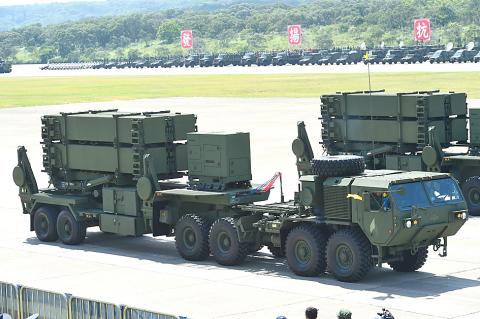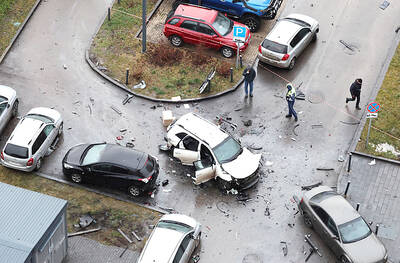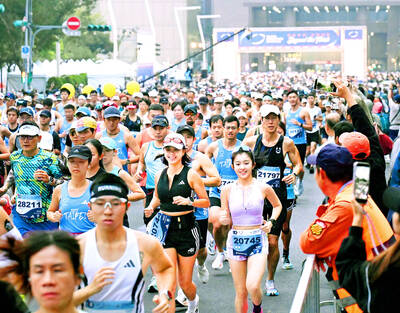A Taiwanese manufacturer has become part of the US-made MIM-104F (PAC-3) Patriot missile supply chain after passing appraisals from the weapon’s developer, sources said, adding that the company has received NT$800 million (US$25.3 million) in international orders.
“Although the PAC-3 missile is an American product, it has Taiwanese technology in its ‘DNA,’” said a high-ranking military official who declined to be named, adding that the local manufacturer has exceptionally good radar-tracking signal management technology that the US contractors wanted.
The radar signal management technology was developed at the Ministry of National Defense-affiliated National Chungshan Institute of Science and Technology and started out as a military product before being released for commercial use, the official said.

Photo: Chang Chia-ming, Taipei Times
The high-speed digital signal management software module was released to a large domestic software company, which then used it in domestic and international military equipment orders, the official said, adding that these orders included the PAC-3 after it passed appraisals by US-based companies Lockheed Martin and Raytheon.
The official said the high-speed software is essential to interception and defense capabilities, adding that the Taiwanese software not only received recognition from foreign firms, but is also used in the Tien Kung III (Sky Bow III) surface-to-air missile system.
Institute vice director Major General Chang Kuan-chun (張冠群) led the institute’s first delegation to an international aerospace exhibition in Japan from Wednesday last week through Saturday.
The delegation exhibited 34 domestically developed defense technology products, including the Tien Kung III, Hsiung Feng II and Hsiung Feng III anti-ship missiles, and medium and large-sized automated drone systems.
The institute said it aims to improve international recognition of Taiwanese defense technology and improve cooperation with international manufacturers in producing both civilian and military products.
The missile system’s technology can be combined with other weapons and communications systems according to customer requirements, the institute said, adding that Taiwanese manufacturers are able to make complete aerospace systems.
Taiwan, South Korea and Japan deploy PAC-3 missile defense systems, the official said, adding that the institute was approached about the design and capabilities of the technology many times over the course of the exhibition.

A car bomb killed a senior Russian general in southern Moscow yesterday morning, the latest high-profile army figure to be blown up in a blast that came just hours after Russian and Ukrainian delegates held separate talks in Miami on a plan to end the war. Kyiv has not commented on the incident, but Russian investigators said they were probing whether the blast was “linked” to “Ukrainian special forces.” The attack was similar to other assassinations of generals and pro-war figures that have either been claimed, or are widely believed to have been orchestrated, by Ukraine. Russian Lieutenant General Fanil Sarvarov, 56, head

SAFETY FIRST: Double the number of police were deployed at the Taipei Marathon, while other cities released plans to bolster public event safety Authorities across Taiwan have stepped up security measures ahead of Christmas and New Year events, following a knife and smoke bomb attack in Taipei on Friday that left four people dead and 11 injured. In a bid to prevent potential copycat incidents, police deployments have been expanded for large gatherings, transport hubs, and other crowded public spaces, according to official statements from police and city authorities. Taipei Mayor Chiang Wan-an (蔣萬安) said the city has “comprehensively raised security readiness” in crowded areas, increased police deployments with armed officers, and intensified patrols during weekends and nighttime hours. For large-scale events, security checkpoints and explosives

A magnitude 7.0 earthquake struck off Yilan at 11:05pm yesterday, the Central Weather Administration (CWA) said. The epicenter was located at sea, about 32.3km east of Yilan County Hall, at a depth of 72.8km, CWA data showed There were no immediate reports of damage. The intensity of the quake, which gauges the actual effect of a seismic event, measured 4 in Yilan County area on Taiwan’s seven-tier intensity scale, the data showed. It measured 4 in other parts of eastern, northern and central Taiwan as well as Tainan, and 3 in Kaohsiung and Pingtung County, and 2 in Lienchiang and Penghu counties and 1

‘POLITICAL GAME’: DPP lawmakers said the motion would not meet the legislative threshold needed, and accused the KMT and the TPP of trivializing the Constitution The Legislative Yuan yesterday approved a motion to initiate impeachment proceedings against President William Lai (賴清德), saying he had undermined Taiwan’s constitutional order and democracy. The motion was approved 61-50 by lawmakers from the main opposition Chinese Nationalist Party (KMT) and the smaller Taiwan People’s Party (TPP), who together hold a legislative majority. Under the motion, a roll call vote for impeachment would be held on May 19 next year, after various hearings are held and Lai is given the chance to defend himself. The move came after Lai on Monday last week did not promulgate an amendment passed by the legislature that